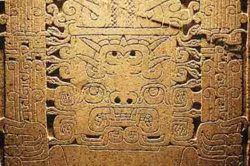
Raimondi Stela
Encyclopedia
The Indigenous deity of the Chavin civilization known as Raimondi Stela is a sacred object and a major piece of art of the Chavín culture
of the central Andes
in present-day Peru
. The stela
is seven feet high, made of highly polished granite
, with a lightly incised design which is almost unnoticeable on the sculpture. For this reason, the design is best studied from a drawing. It is housed in the courtyard of the Museo Nacional de Arqueología Antropología e Historia del Perú in Lima
. Chavin artists frequently used the technique of contour rivalry
Chavin artists frequently used the technique of contour rivalry
in their art forms, and this indigenous deity is considered one of the finest known examples of this technique. Contour rivalry means that the lines in an image can be read in multiple ways, depending on which way the object is being viewed. When the Raimondi Stela is viewed one way, the image depicts a fearsome deity holding two staffs. His eyes look upward toward his large, elaborate headdress of snakes and volutes. When flipped upside-down, the same image can be seen differently. The headdress can be "read" as a stacked row of smiling, fanged faces, while the deity's face has turned into the face of a smiling reptile. The deity's staffs also appear to be rows of stacked faces.
This technique speaks to larger Andean concerns of the duality and reciprocal nature of nature, life, and society. This theme is found in the art of many other Andean indigenous civilizations.
Chavín culture
The Chavín were a civilization that developed in the northern Andean highlands of Peru from 900 BC to 200 BC. They extended their influence to other civilizations along the coast. The Chavín were located in the Mosna Valley where the Mosna and Huachecsa rivers merge...
of the central Andes
Andes
The Andes is the world's longest continental mountain range. It is a continual range of highlands along the western coast of South America. This range is about long, about to wide , and of an average height of about .Along its length, the Andes is split into several ranges, which are separated...
in present-day Peru
Peru
Peru , officially the Republic of Peru , is a country in western South America. It is bordered on the north by Ecuador and Colombia, on the east by Brazil, on the southeast by Bolivia, on the south by Chile, and on the west by the Pacific Ocean....
. The stela
Stele
A stele , also stela , is a stone or wooden slab, generally taller than it is wide, erected for funerals or commemorative purposes, most usually decorated with the names and titles of the deceased or living — inscribed, carved in relief , or painted onto the slab...
is seven feet high, made of highly polished granite
Granite
Granite is a common and widely occurring type of intrusive, felsic, igneous rock. Granite usually has a medium- to coarse-grained texture. Occasionally some individual crystals are larger than the groundmass, in which case the texture is known as porphyritic. A granitic rock with a porphyritic...
, with a lightly incised design which is almost unnoticeable on the sculpture. For this reason, the design is best studied from a drawing. It is housed in the courtyard of the Museo Nacional de Arqueología Antropología e Historia del Perú in Lima
Lima
Lima is the capital and the largest city of Peru. It is located in the valleys of the Chillón, Rímac and Lurín rivers, in the central part of the country, on a desert coast overlooking the Pacific Ocean. Together with the seaport of Callao, it forms a contiguous urban area known as the Lima...
.

Contour rivalry
Contour rivalry is an artistic technique used to create multiple possible visual interpretations of an image. An image may be viewed as depicting one thing when viewed in a certain way; but if the image is flipped or turned, the same lines that formed the previous image now make up an entirely new...
in their art forms, and this indigenous deity is considered one of the finest known examples of this technique. Contour rivalry means that the lines in an image can be read in multiple ways, depending on which way the object is being viewed. When the Raimondi Stela is viewed one way, the image depicts a fearsome deity holding two staffs. His eyes look upward toward his large, elaborate headdress of snakes and volutes. When flipped upside-down, the same image can be seen differently. The headdress can be "read" as a stacked row of smiling, fanged faces, while the deity's face has turned into the face of a smiling reptile. The deity's staffs also appear to be rows of stacked faces.
This technique speaks to larger Andean concerns of the duality and reciprocal nature of nature, life, and society. This theme is found in the art of many other Andean indigenous civilizations.
External links
- Raimondi Stela Full Image

